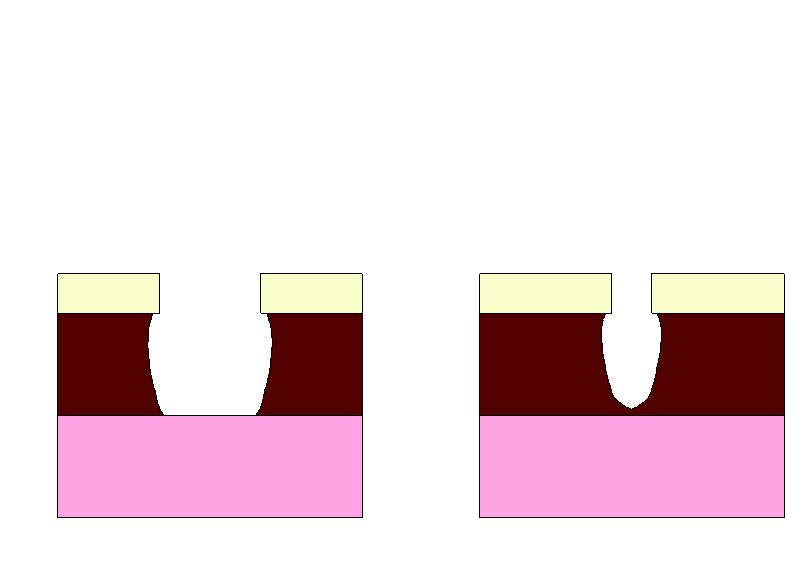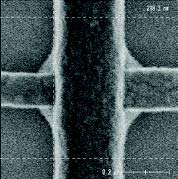Sentaurus Topo and Litho graphy...still have hope
时间:03-15
整理:3721RD
点击:
Sentaurus Topography
Advanced Topography Simulator
Overview
Sentaurus Topography is an advanced two-dimensional simulator for the physical modeling of topographymodifying
process steps such as deposition, etching, spin-on-glass, reflow, and chemical-mechanical polishing.
It supports complex process structures of multiple layers with different material properties, and it uses
advanced physical models and numeric algorithms. Sentaurus Topography is ideal for predicting the topography
of back-end processes by simulating the complex steps used to build the interconnect layers.
Process development engineers can use Sentaurus Topography to optimize existing processes and to develop
new process flows. In manufacturing, Sentaurus Topography is a key tool to study the effects of misalignment
and process variation to improve process capability and yield.
In addition, the interface between Sentaurus Topography and Sentaurus Process allows users to combine frontend
thermal and topography simulations in one environment. Sentaurus Topography is fully integrated into
Sentaurus Workbench, the state-of-the-art Synopsys TCAD framework and visualization tool.
Benefits
• Simulates profile evolutions of deposition and etching
processes, including APCVD, LPCVD, PECVD, HDP CVD,
wet etch, reactive ion etch (RIE), ion milling, and sputter etch
• Emulates reflow, spin-on-glass, and chemical-mechanical
polishing
• Simulates etching characteristics under different reactor
conditions leading to sidewall bowing, etchback planarization,
and RIE lag effects
• Investigates impact of sidewall angle and deposition conditions
on trench or contact filling and void formation
• Characterizes plasma discharge and sheath transport
mechanisms including plasma (ions and neutral) angle and
energy distribution at wafer surface
Description
The rising complexity in process technologies – more metal
layers, smaller geometries with high aspect ratio structures,
tighter specifications for film thickness uniformity, and new
materials – contributes to significant challenges in process
development and integration. Sentaurus Topography can help
process engineers meet these challenges. The tool combines
flexible models for common topography-modifying process
steps with robust level set methods to handle difficult numeric
problems resulting from boundary evolution in topography
simulation.
Sentaurus Topography creates two-dimensional structures using
a command language describing the process flow. In addition,
boundary files (in TDR or SAT format) of the structures created
by Sentaurus Process or Sentaurus Structure Editor can be
imported by Sentaurus Topography. Conversely, boundary
files written by Sentaurus Topography can be used for further
processing in Sentaurus Process or Sentaurus Structure Editor.
Structure generation in Sentaurus Topography includes
geometric deposition and etching modes, which can be used
to generate initial structures for machine-based deposition and
etching.
Sentaurus Lithography
Predictive Computational Lithography for
Accelerated Process Development
Overview
Sentaurus Lithography represents advanced lithography process simulation within TCAD Sentaurus,
the physics-oriented technology simulation product family. It covers a range of applications in optical,
immersion, extreme ultraviolet (EUV), and electron beam (e-beam) lithography, allowing thorough
analysis of fundamental effects within the illumination and projection systems of an exposure tool,
predicting the impact of mask and wafer topography on photoresist profiles.
While simulation is important to address the lithography challenges of a certAIn technology node,
the integration of simulation into process development, design, and manufacturing flows is just as
essential. Integrating Sentaurus Lithography with Sentaurus Topography allows a seamless modeling
of complex technologies such as double-patterning. The interfaces of Sentaurus Lithography to other
Synopsys applications in the area of design and mask synthesis accelerate the generation of optical
proximity correction (OPC) models, minimizing process variability.
Technology simulation plays an invaluable role in the field of
advanced process development and optimization. Simulation
effectively minimizes experimental engineering lots and
short-loop experiments, resulting in accelerated process
development, considerable cost-savings, and a faster time-tomarket.
Sentaurus Lithography provides all the computational
lithography capabilities necessary to enable engineers to
make precise and reliable predictions on the performance of
lithography processes and strategies. Individual modules of
Sentaurus Lithography address challenges in all relevant areas.
Sentaurus Lithography offers a comprehensive feature set,
using the predictive power of computational lithography to
cost-effectively explore complex technology options, defining
the lithography strategy for current and future technology
nodes, extending from single exposures in dry lithography to the
application of immersion and multiple exposure or patterning
techniques. In addition, effects specific to EUV and e-beam
lithography can be investigated. All features are embedded in
an intuitive graphical user interface, which allows engineers to
navigate easily through a wide range of lithography simulation
capabilities. Extensive scripting functionality allows users to set
up and automate complex simulation scenarios, and supports
the integration into customized workflows.
Advanced algorithms of Sentaurus Lithography use state-ofthe-
art hardware resources such as multicore cpus or highperformance
computation clusters in an optimum way, which
enables engineers to address highly complex, multidimensional
problems or the simulation of large areas in a timely manner.
Benefits
Explore major technology options for manufacturability
Immersion lithography over arbitrary wafer topography
Double-patterning techniques
EUV lithography
E-beam lithography
Optimize process windows and analyze process variability
Guide experiments for efficient process development
Evaluate impact of restrictive design rules on resist contours.....................................................................
Advanced Topography Simulator
Overview
Sentaurus Topography is an advanced two-dimensional simulator for the physical modeling of topographymodifying
process steps such as deposition, etching, spin-on-glass, reflow, and chemical-mechanical polishing.
It supports complex process structures of multiple layers with different material properties, and it uses
advanced physical models and numeric algorithms. Sentaurus Topography is ideal for predicting the topography
of back-end processes by simulating the complex steps used to build the interconnect layers.
Process development engineers can use Sentaurus Topography to optimize existing processes and to develop
new process flows. In manufacturing, Sentaurus Topography is a key tool to study the effects of misalignment
and process variation to improve process capability and yield.
In addition, the interface between Sentaurus Topography and Sentaurus Process allows users to combine frontend
thermal and topography simulations in one environment. Sentaurus Topography is fully integrated into
Sentaurus Workbench, the state-of-the-art Synopsys TCAD framework and visualization tool.
Benefits
• Simulates profile evolutions of deposition and etching
processes, including APCVD, LPCVD, PECVD, HDP CVD,
wet etch, reactive ion etch (RIE), ion milling, and sputter etch
• Emulates reflow, spin-on-glass, and chemical-mechanical
polishing
• Simulates etching characteristics under different reactor
conditions leading to sidewall bowing, etchback planarization,
and RIE lag effects
• Investigates impact of sidewall angle and deposition conditions
on trench or contact filling and void formation
• Characterizes plasma discharge and sheath transport
mechanisms including plasma (ions and neutral) angle and
energy distribution at wafer surface
Description
The rising complexity in process technologies – more metal
layers, smaller geometries with high aspect ratio structures,
tighter specifications for film thickness uniformity, and new
materials – contributes to significant challenges in process
development and integration. Sentaurus Topography can help
process engineers meet these challenges. The tool combines
flexible models for common topography-modifying process
steps with robust level set methods to handle difficult numeric
problems resulting from boundary evolution in topography
simulation.
Sentaurus Topography creates two-dimensional structures using
a command language describing the process flow. In addition,
boundary files (in TDR or SAT format) of the structures created
by Sentaurus Process or Sentaurus Structure Editor can be
imported by Sentaurus Topography. Conversely, boundary
files written by Sentaurus Topography can be used for further
processing in Sentaurus Process or Sentaurus Structure Editor.
Structure generation in Sentaurus Topography includes
geometric deposition and etching modes, which can be used
to generate initial structures for machine-based deposition and
etching.
Sentaurus Lithography
Predictive Computational Lithography for
Accelerated Process Development
Overview
Sentaurus Lithography represents advanced lithography process simulation within TCAD Sentaurus,
the physics-oriented technology simulation product family. It covers a range of applications in optical,
immersion, extreme ultraviolet (EUV), and electron beam (e-beam) lithography, allowing thorough
analysis of fundamental effects within the illumination and projection systems of an exposure tool,
predicting the impact of mask and wafer topography on photoresist profiles.
While simulation is important to address the lithography challenges of a certAIn technology node,
the integration of simulation into process development, design, and manufacturing flows is just as
essential. Integrating Sentaurus Lithography with Sentaurus Topography allows a seamless modeling
of complex technologies such as double-patterning. The interfaces of Sentaurus Lithography to other
Synopsys applications in the area of design and mask synthesis accelerate the generation of optical
proximity correction (OPC) models, minimizing process variability.
Technology simulation plays an invaluable role in the field of
advanced process development and optimization. Simulation
effectively minimizes experimental engineering lots and
short-loop experiments, resulting in accelerated process
development, considerable cost-savings, and a faster time-tomarket.
Sentaurus Lithography provides all the computational
lithography capabilities necessary to enable engineers to
make precise and reliable predictions on the performance of
lithography processes and strategies. Individual modules of
Sentaurus Lithography address challenges in all relevant areas.
Sentaurus Lithography offers a comprehensive feature set,
using the predictive power of computational lithography to
cost-effectively explore complex technology options, defining
the lithography strategy for current and future technology
nodes, extending from single exposures in dry lithography to the
application of immersion and multiple exposure or patterning
techniques. In addition, effects specific to EUV and e-beam
lithography can be investigated. All features are embedded in
an intuitive graphical user interface, which allows engineers to
navigate easily through a wide range of lithography simulation
capabilities. Extensive scripting functionality allows users to set
up and automate complex simulation scenarios, and supports
the integration into customized workflows.
Advanced algorithms of Sentaurus Lithography use state-ofthe-
art hardware resources such as multicore cpus or highperformance
computation clusters in an optimum way, which
enables engineers to address highly complex, multidimensional
problems or the simulation of large areas in a timely manner.
Benefits
Explore major technology options for manufacturability
Immersion lithography over arbitrary wafer topography
Double-patterning techniques
EUV lithography
E-beam lithography
Optimize process windows and analyze process variability
Guide experiments for efficient process development
Evaluate impact of restrictive design rules on resist contours.....................................................................



please
想呀!
Thanks... Great Info
我也等待好人的分享!谢谢!
没有什么用
